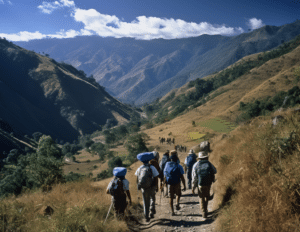Introduction – Ecotourism In Mexico
Ecotourism represents a mindful travel approach, considering both environmental impact and unique cultural experiences. This guide aims to introduce you to the ecotourism in Mexico, uncovering a path to sustainable travel.

What is Ecotourism in Mexico?
Ecotourism in Mexico revolves around sustainable travel that considers the environment and benefits local communities. This concept germinated in the 1980s when Mexico started promoting sustainable tourism to conserve its diverse ecology and rich cultural heritage.
Top Ecotourism Destinations in Mexico
Mexico offers vast ecotourism destinations promising physical beauty and immersive experiences. Visit the whale nurseries in the Baja California Peninsula, the monarch butterfly reserves of Michoacán, or the pristine beaches of Tulum. Among its hidden gems is Xochimilco, a UNESCO World Heritage site, known for its extensive system of canals and floating gardens.
Eco-Friendly Resorts in Mexico
Playa Viva
Playa Viva is an eco-lodge made entirely from natural materials. Located in Juluchuca, the resort offers yoga sessions, locally-sourced meals, and unspoiled beachfront views. It truly epitomizes the spirit of sustainable living while offering pure relaxation and peace.
Cuixmala
Situated within a massive nature reserve, Cuixmala presents a luxurious take on eco-tourism. The resort, inspired by Moorish architecture, offers organic farms, turtle conservation projects, and a variety of outdoor activities with minimum environmental impact.
Ecotourism Activities in Mexico
Ecotourism in Mexico extends beyond sightseeing – it’s about engaging with nature and culture. Try bird-watching in Sierra Gorda, jungle trekking in Lacandon, or assist a turtle conservation project in Puerto Vallarta. We tell you a bit about each activity here.
Bird-watching in Sierra Gorda
Sierra Gorda, located in the heart of Mexico, is one of the most ecologically rich and diverse places in the country.
It is home to hundreds of bird species, some of which are endemic and can’t be found anywhere else in the world, making it a paradise for bird watchers.
Guided tours led by knowledgeable locals or professional ornithologists provide an excellent way to learn about these birds and their habitats.
Observing these birds in their natural environment is a deeply enriching experience, and it also contributes to the local economy, helping fund conservation efforts in the region.
Jungle Trekking in Lacandon
The Lacandon Jungle, located in the state of Chiapas in Southern Mexico, is one of the last remaining rainforests in North America.
It’s home to a rich diversity of plant and animal species, some of which are endangered.
Jungle trekking in Lacandon offers a unique opportunity to explore this dense and beautiful rainforest, providing a firsthand encounter with nature’s magnificence.
Tourists can hike through lush vegetation, see breathtaking waterfalls, visit ancient Mayan ruins, and learn about the traditional lifestyle of the indigenous Lacandon people, who have lived in harmony with the jungle for centuries.
Turtle Conservation Project in Puerto Vallarta
Puerto Vallarta, situated on the Pacific coast of Mexico, is known for its beautiful beaches, and is also an important nesting site for several species of sea turtles.
Each year, between June and December, turtles come ashore to lay their eggs.
The turtle conservation projects in Puerto Vallarta invite tourists to participate in a variety of conservation activities, such as night patrols to protect the turtles, collecting and relocating eggs to safe hatcheries, and releasing baby turtles back into the sea.
This hands-on involvement not only provides a unique and memorable experience, but also raises awareness about the importance of marine conservation.
Why Ecotourism in Mexico Makes Sense
You might be wondering whether you’re really supporting something meaningful for preserving natural ecosystems or is this a tourism gimmick.
Actually, ecotourism in Mexico makes sense for several reasons, especially considering the country’s unique geographical features, rich biodiversity, cultural diversity, and the current global trend towards sustainable travel.
- Rich biodiversity and unique geography: Mexico is one of the 17 megadiverse countries in the world, recognized by the United Nations for their exceptionally rich biodiversity. It is home to a variety of ecosystems, ranging from deserts and mountains to tropical rainforests and coral reefs, providing a plethora of opportunities for nature-based tourism.
- Cultural heritage: In addition to its natural attractions, Mexico is rich in cultural heritage, with numerous indigenous communities and historical sites. Ecotourism can provide a platform for these communities to preserve and share their culture, and create economic opportunities.
- Sustainable Development: As a part of its commitment to sustainable development, Mexico has an interest in promoting practices that balance economic growth with environmental protection. Ecotourism, by definition, involves low-impact, responsible travel that conserves the environment and improves the well-being of local people. It can serve as a tool for both conservation and sustainable development.
- Existing Protected Areas: Mexico has numerous protected areas and biosphere reserves, which are ideal settings for ecotourism. These protected areas are designed to conserve the country’s unique biodiversity, and ecotourism can provide the financial support needed for their maintenance and management.
- Global Trends: There is a growing global trend towards more sustainable and responsible travel. More and more travelers are seeking experiences that are environmentally friendly and that benefit local communities. Mexico’s commitment to ecotourism puts it in a good position to tap into this market.
- Economic Opportunities for Local Communities: Ecotourism often emphasizes local involvement and benefits. It can provide new job opportunities for local people, fund conservation efforts, and contribute to local economies in regions where other forms of economic development may be less feasible.
- Education and Conservation: Ecotourism often involves an educational component, promoting awareness and understanding of environmental and cultural issues. This can contribute to conservation efforts and foster a culture of respect for nature and indigenous cultures.
Carbon Reduction and Sustainability
Travel, though enriching, can inevitably contribute to the carbon footprint. Ecotourism in Mexico, however, is a conscious effort to reduce this environmental impact.
Consider using EcoBici, Mexico City’s public bicycle sharing system. It’s designed to promote sustainable urban transport and reduce CO2 emissions.
Sustainable Travel Tips
Sustainable travel means reducing your environmental impact while enriching the local economy and respecting traditions.
Buy locally made products, avoid single-use plastics, and use public transportation when possible. Also, consider resources like “Lonely Planet,” renowned for its responsible travel tips and guides.
Conclusion – Ecotourism In Mexico

Exploring Mexico through the lens of ecotourism represents an effortless conservation effort, providing an unforgettable experience.
Your conscious travel choices will help protect Mexico’s vibrant natural and cultural heritage for generations to come.
Resources
Before setting off, be sure to delve into other practical resources like green travel guides and eco tourism handbooks.
